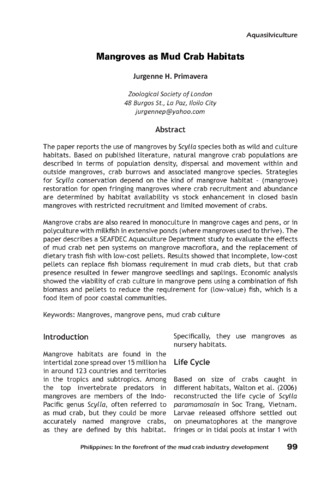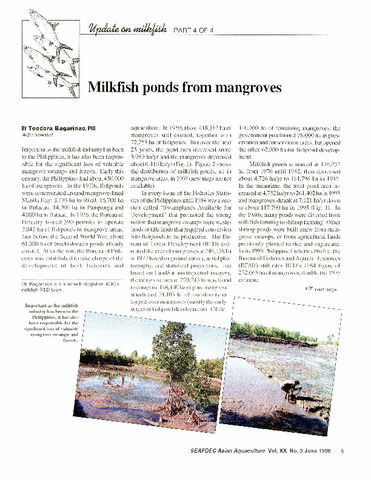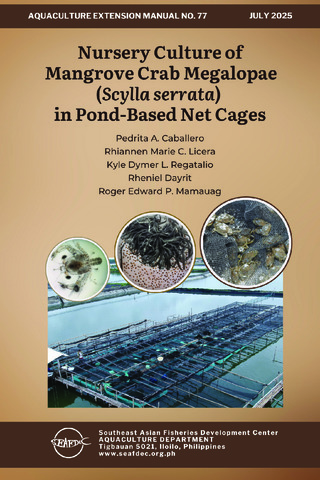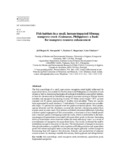Mangroves as mud crab habitats
- Global styles
- MLA
- Vancouver
- Elsevier - Harvard
- APA
- Help

Date
2017Author
Page views
6,671ASFA keyword
aquaculture economics 
aquaculture techniques
associated species
cage culture
crab culture
culture effects
feeds
feeding
habitat improvement (biological)
habitats
mangrove swamps
mangroves
marine crustaceans
monoculture
polyculture (aquaculture)
population density
population dynamics
resource conservation
seedlings
stocking (organisms)
stocks

aquaculture techniques

associated species

cage culture

crab culture

culture effects

feeds

feeding

habitat improvement (biological)

habitats

mangrove swamps

mangroves

marine crustaceans

monoculture

polyculture (aquaculture)

population density

population dynamics

resource conservation

seedlings

stocking (organisms)

stocks

AGROVOC keyword
Metadata
Perlihat publikasi penuhShare
Abstract
The paper reports the use of mangroves by Scylla species both as wild and culture habitats. Based on published literature, natural mangrove crab populations are described in terms of population density, dispersal and movement within and outside mangroves, crab burrows and associated mangrove species. Strategies for Scylla conservation depend on the kind of mangrove habitat - (mangrove) restoration for open fringing mangroves where crab recruitment and abundance are determined by habitat availability vs stock enhancement in closed basin mangroves with restricted recruitment and limited movement of crabs.
Mangrove crabs are also reared in monoculture in mangrove cages and pens, or in polyculture with milkfish in extensive ponds (where mangroves used to thrive). The paper describes a SEAFDEC Aquaculture Department study to evaluate the effects of mud crab net pen systems on mangrove macroflora, and the replacement of dietary trash fish with low-cost pellets. Results showed that incomplete, low-cost pellets can replace fish biomass requirement in mud crab diets, but that crab presence resulted in fewer mangrove seedlings and saplings. Economic analysis showed the viability of crab culture in mangrove pens using a combination of fish biomass and pellets to reduce the requirement for (low-value) fish, which is a food item of poor coastal communities.
Suggested Citation
Primavera, J. H. (2017). Mangroves as mud crab habitats. In E. T. Quinitio, F. D. Parado-Estepa, & R. M. Coloso (Eds.), Philippines : In the forefront of the mud crab industry development : proceedings of the 1st National Mud Crab Congress, 16-18 November 2015, Iloilo City, Philippines (pp. 99-103). Tigbauan, Iloilo, Philippines: Aquaculture Department, Southeast Asian Fisheries Development Center.
Type
Conference paperISBN
9789719931072
Related items
Showing items related by title, author, creator and subject.
-
Series: Aquaculture extension manual; No. 77
Nursery culture of mangrove crab megalopae (Scylla serrata) in pond-based net cages
Caballero, Pedrita ; Licera, Rhiannen Marie C.; Regatalio, Kyle Dymer
; Licera, Rhiannen Marie C.; Regatalio, Kyle Dymer  ; Dayrit, Rheniel; Mamauag, Roger Edward
; Dayrit, Rheniel; Mamauag, Roger Edward  (Aquaculture Department, Southeast Asian Fisheries Development Center, 2025-07)
This manual, titled “Nursery Culture of Mangrove Crab Megalopae (Scylla serrata) in Pond-Based Net Cages,” is part of SEAFDEC/AQD’s effort to assess the potential of using megalopae as the starting stock in pond-based ...
(Aquaculture Department, Southeast Asian Fisheries Development Center, 2025-07)
This manual, titled “Nursery Culture of Mangrove Crab Megalopae (Scylla serrata) in Pond-Based Net Cages,” is part of SEAFDEC/AQD’s effort to assess the potential of using megalopae as the starting stock in pond-based ... -
Fish habitats in a small, human-impacted Sibunag mangrove creek (Guimaras, Philippines): a basis for mangrove resource enhancement
The fish assemblage of a small, open access mangrove creek highly influenced by aquaculture farms, was studied for the first time in the Philippines as a baseline of such system as well as examining the degree of ecological ...




